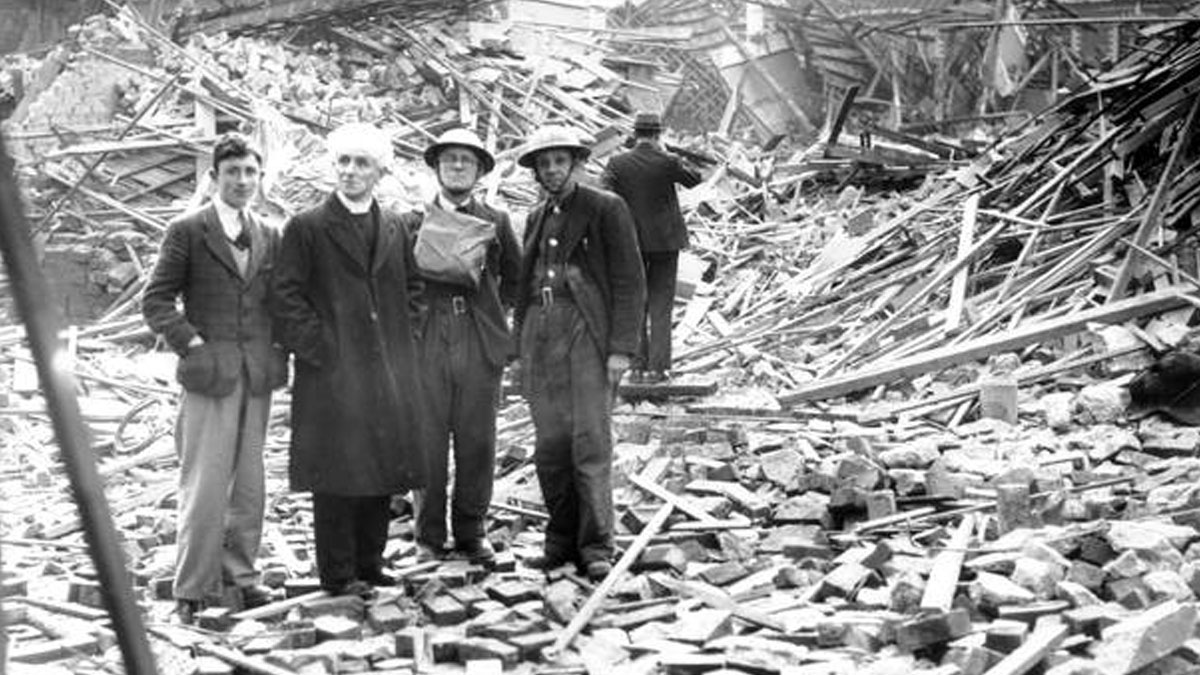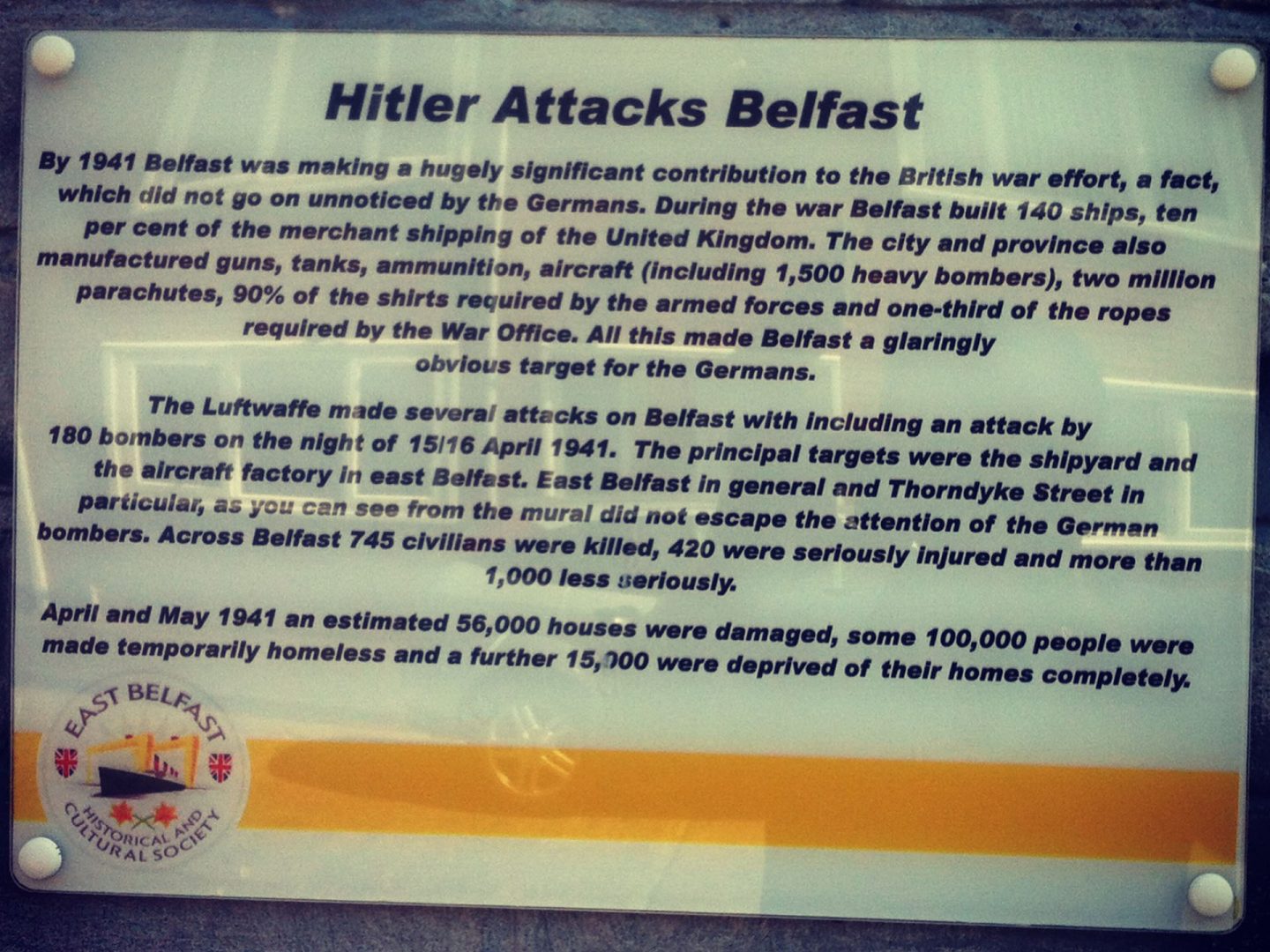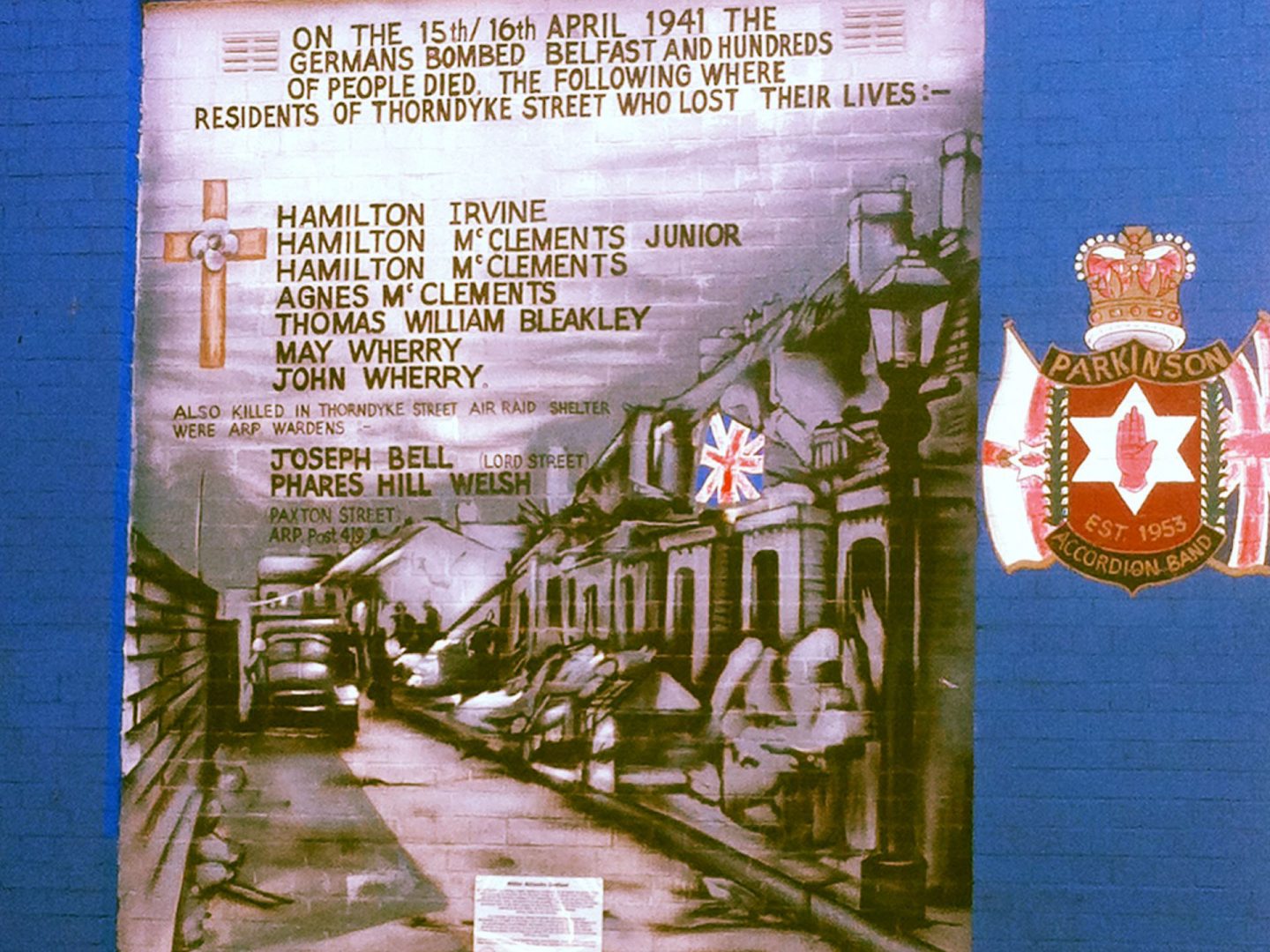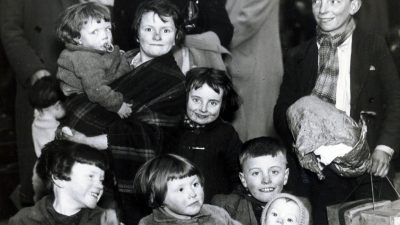Thorndyke Street, Belfast runs between Templemore Avenue and Lord Street. Before and during the early years of the Second World War, the East Belfast street was a quiet, close-knit residential community. The Belfast Blitz would change the street forever.
Thorndyke Street stands not far from the Harland and Wolff Shipyard. Many residents in 1939 held jobs that may have seen them employed in the yard as riveters, machinists, platers, etc. In 1941, the shipyard and surrounding industrial area was a prime target for the Luftwaffe. Nearby residential areas suffered as errant bombs missed their targets and fell on the terraced houses of East Belfast. Streets such as Westbourne Street, Newcastle Street, and Ravenscroft Avenue sustained great damage. In Thorndyke Street, however, the loss of life was particularly high.

Belfast Telegraph Photo: AR 175 (Part of the Belfast Telegraph Collection). Alexander Irwin Thompson stands next to his father Reverend MA Thompson (Mountpottinger Presbyterian Church), and 2 Air Raid Precautions volunteers near the site of where the air raid shelter had stood on Thorndyke Street, Belfast. This photo is part of a collection published in 'Bombs on Belfast: The Blitz 1941'. Photo taken on 16th April 1941. Copyright Belfast Telegraph.
Many of those who perished during the Belfast Blitz on Thorndyke Street died when the public air raid shelter in the street collapsed. According to Brian Barton’s ‘The Belfast Blitz: The City In The War Years’, a 250lb high explosive bomb detonated around 45 yards from the shelter. The blast between the terraced houses of Thorndyke Street and Chatsworth Street caused the walls of the shelter to give way. As a result, the reinforced concrete roof fell onto those sheltering beneath it. Barton states over 20 people died on Thorndyke Street, 14 of them in the shelter.
A large number of houses in the street also sustained great damage leaving them uninhabitable after the Blitz. On one side of the street, the blast destroyed 7 terraced houses.
Shortly after the Luftwaffe attack, Reverend MA Thompson of Mountpottinger Presbyterian Church visited Thorndyke Street. A Belfast Telegraph photographer captured the moment when he, his son Alexander Irwin Thompson, and a pair of Air Raid Precautions volunteers surveyed the damage. The Thompson’s had gone to visit the home of one of their parishioner families. The warden shown in the photograph wearing a respirator on his chest assured the minister that the family had evacuated before the raid. Alexander Irwin Thompson recalled 11 people dying in the air-raid shelter.
Not everyone from the area had access to the debris-strewn street in the aftermath of the attack as Norman Kennedy states in Stephen Douds’ ‘The Belfast Blitz: The People’s Story’.
I went down the Albertbridge Road the morning after and you were tripping over fire hoses; you weren’t allowed down Thorndyke Street, for example. They had very, very, heavy casualties.
Norman Kennedy, Holywood Arches, Belfast.
Belfast Blitz casualties in Thorndyke Street
The Commonwealth War Graves Commission list of civilian casualties records 9 deaths in the shelter and a further 8 deaths on the street. This total of 17 differs slightly to the often quoted total of 20 deaths. A resident of 12 Thorndyke Street, Miss Sarah Hughes died as a result of her injuries at the Royal Victoria Hospital, Belfast on 17th April 1941.
The Commonwealth War Graves Commission records the following deaths in Thorndyke Street on 15th-16th April 1941; Joseph Bell (an ARP Warden of 5 Lord Street), Phares Hill Welsh (an ARP Messenger of 28 Paxton Street), and Elizabeth Wherry, John Wherry, Martha Wherry, Mary Wherry, Margaret Jane Wherry, and Robert Wherry (all of 16 Thorndyke Street).
In addition, the Commonwealth War Graves Commission records the following deaths in the Thorndyke Street Shelter on the same night; Matilda Violet Bleakley, Thomas William Bleakley, Mary Ann Crotty (all of 8 Thorndyke Street), Hamilton Irvine (14 Thorndyke Street), Agnes McClements, Hamilton McClements Sr., Hamilton McClements Jr. (all of 13 Thorndyke Street), William Murray (13 Cherryville Street), and William Stewart (3 Lord Street).
Even within these lists, there are minor discrepancies. The 6 members of the Wherry family died in Thorndyke Street according to this list rather than in the shelter. However, on 26th June 1941, Robert Wherry Jr. gave evidence at an inquest held by Coroner Dr. Herbert P Lowe at Belfast City Hall.
Wherry stated that he left his mother Margaret Jane Wherry, father Robert Wherry Sr., and sister Martha Wherry and Elizabeth Wherry in the shelter. Robert too had been in the shelter since around 2330hrs but felt tired after 0230hrs and left to go home much to his family’s displeasure.
Coroner Lowe: What prompted you to do that?
Robert Wherry: I was tired standing in the shelter.
Coroner Lowe: Did the others not go with you?
Robert Wherry: No, they coaxed me to stay.
He climbed into bed and after no more than 15 minutes heard a “terrific explosion”. The force of the blast knocked him to the floor. After the all-clear, he rushed back to the street finding the shelter demolished.
The Haggan family at 49 Thorndyke Street had come through tragedy once before on 15th April. On that date in 1912, the ill-fated Titanic sank. John Haggan of Thorndyke Street who was a Fireman on board the Harland and Wolff built vessel survived. A Miss S Haggan resided at the same address in both 1939 and 1943.
A modern mural stands on Thorndyke Street commemorating events throughout the area’s history. Painted in October 2004, one panel recalls the events of 15th-16th April 1941. The painting shows the aftermath in the street after the fall of the Luftwaffe bombs. It also lists the names of 7 residents of the street and 2 Air Raid Precautions volunteers who died as a result of the attack. A plaque next to the mural reads:
By 1941 Belfast was making a hugely significant contribution to the British war effort, a fact, which did not go on unnoticed by the Germans. During the war, Belfast built 140 ships, ten percent of the merchant shipping of the United Kingdom. The city and province also manufactured guns, tanks, ammunition, aircraft (including 1,500 heavy bombers), two million parachutes, 90% of the shirts required by the armed forces and one-third of the ropes required by the War Office. All this made Belfast a glaringly obvious target for the Germans. The Luftwaffe made several attacks on Belfast with including an attack by 180 bombers on the night on 15th and 16th April 1941. The principal targets were the shipyard and the aircraft factory in east Belfast. East Belfast in general and Thorndyke Street in particular, as you can see from the mural did not escape the attention of the German bombers. Across Belfast 745 civilians were killed, 420 were seriously injured and more than 1,000 less seriously. April and May 1941 an estimated 56,000 houses were damaged, some 100,000 people were made temporarily homeless and a further 15,000 were deprived of their homes completely.
Thorndyke Street Mural – Belfast, October 2004
Those named on the mural are Joseph Bell, Phares Hill Welsh, John Wherry, May (possibly Mary) Wherry, Thomas William Bleakley, Hamilton Irvine, Agnes McClements, Hamilton McClements Sr., and Hamilton McClements Jr.
In 2016, to mark the 75th anniversary of the Belfast Blitz, Belfast City Council unveiled memorial plaques across the city. One of these stands at the end of Thorndyke Street on the side wall of the Iron Hall on Templemore Avenue. This plaque states that 20 people died on Thorndyke Street during The Easter Raid.
Thorndyke Street in 1939
The following information is taken from the 1939 Belfast Street Directory.
Thorndyke Street in 1943
The following information is taken from the 1943 Belfast Street Directory.




